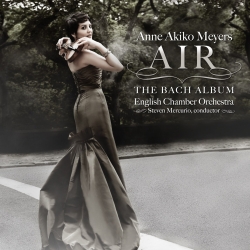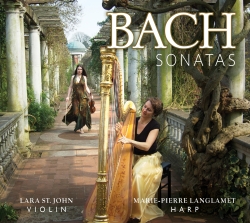
Air - The Bach Album
There can hardly have been a composer more impervious to transcription than J.S. Bach. Never mind his own reuses of older pieces (Handel beats him there, I think, as the ultimate “green composer,” recycling whenever feasible); I’m talking about the uses other people have made of the music. So much of it seems so very durable.
You can take all the words out of a chorale-based aria from a Bach cantata, for example, then reassign the chorale line to cello solo, and have myriad listeners marveling at the beauty of the music without knowing, or caring, what the sung text said. You can switch instruments almost ad infinitum, it seems. We’ve had the Goldberg Variations on every imaginable keyboard instrument, including accordion, and played by string trios and string orchestras and viol consorts and (for all I know) ambitious saxophone quartets. The Air on the G String has been arranged for every instrument in the band/orchestra ambit, and basically all fretted instruments, and I’m not even counting the Swingle Singers’ version, which I’m willing to bet isn’t the sole vocal arrangement.
Listen To The Music


Lara St. John - Bach Sonata No. 3, III. Adagio ma non tanto

So there isn’t really any disincentive to messing about with Bach; whatever you do with it, it’s likely going to work.
Two distinguished violinists have new Bach albums out, and both of them do a bit of “messing about.” Lara St. John’s new album of Bach sonatas — originally for violin (or flute) and keyboard, but with the keyboard part performed by longtime Berlin Philharmonic harpist Marie-Pierre Langlamet — puts a new spin on the works … and, I’d say, on St. John. Anne Akiko Meyers’ Bach album, titled Air, gets into different difficulties.
To take the latter first: The selling-point so far for Meyers’ recording (apart from the alluring cover art — something she has in common with St. John and Langlamet) has been her recording of the Bach Double Concerto (BWV 1043) with herself as both soloists, via overdubbing. This has been done only once before, so far as I know — by Gidon Kremer, in the late ’70s — and no one has repeated the experiment since, until now. But even Kremer didn’t boast (as Meyers does) that the first solo part was recorded on one of the soloist’s two Strads, and the other one on the other. I don’t see what the point is here, since we aren’t told what instruments are used for anything else on the disc. (Nor told such basic stuff as how long the tracks are. The booklet is minimalist in almost everything but fetching images of Meyers, including the cover one in which she’s holding what I devoutly hope isn’t a Strad across the back of her bare neck, while walking in a skirt that looks positively designed to make her trip.)

This is an unfair way to present a very fine violinist. Meyers’ playing in the two solo concertos is first-rate. I could wish she were miked a little (OK, a lot) less closely, and at places details get lost, like the top notes at the end of the bariolage in the A-minor Concerto’s finale. Her playing is clean and incisive, even if I find the fast, wide vibrato a bit much. The “Double” is good, to the ear; but what must it have been like for the English Chamber Orchestra to record this with only one soloist?
And the extras, like the titular Air? It’s said to have been arranged by Jeff Kyrka, but apart from making the strings all play pianissimo and the basses pizzicato, I don’t hear that anything’s been arranged anywhere. It’s just the original Bach, only with the top line amplified and everything else as written, though relegated to accompaniment. If you’re going to do it that way, you might as well play the Air on a G String with piano and dispense with the orchestra. The original — which, to be clear, is what’s played here — has marvelously rich second violin and viola parts. I think the ECO middle strings would dig in more, were they allowed.
There isn’t really any disincentive to messing about with Bach; whatever you do with it, it’s likely going to work.
Lara St. John’s latest Bach disc is a quite different project. She and harpist Marie-Pierre Langlamet have taken two of Bach’s violin-and-keyboard sonatas, plus two Bach flute-and-keyboard sonatas, and performed them on violin and harp.
Does it work? Well, naturally it does; it’s, again, extremely difficult to mis-transcribe Bach. Yet there’s still something lost in translation here.
Something gained, too: You can do many things on a harp that you can’t on a harpsichord, like vary dynamics and articulation. What you lose, though, is the harpsichord’s sharp, incisive sound. The serious comparison is with the piano, which is what almost everyone used in these sonatas until maybe 30 years ago. The piano has the variety of articulation and dynamics of the harp (a lot more, really), but it’s a good deal louder at the top end, making the style of violin-playing it encourages much burlier.
The style St. John adopts here is anything but burly. The slow movements are dreamily beautiful. Yet in the fast ones she sounds as though she’s afraid of drowning out the harp, and the result is a sort of mincing articulation that I never would have expected from the violinist whose debut solo Bach disc on the Well-Tempered label (the D-minor Partita and C-major Sonata) had such strength (of purpose and of bow-arm and of chording technique) audible in every phrase. This disc is uncomfortably close to “pretty.” Bach can be pretty; Bach can be practically anything. Yet Bach can be more; and St. John’s Bach has been more.

